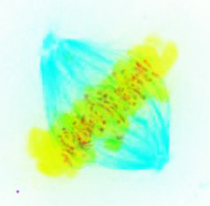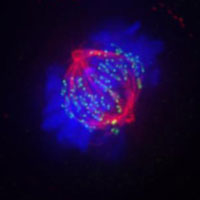New mechanism discovered - protects our genetic material

Chromosomes aligned on the metaphase plate with Bub1(red) on kinetochores.
Latest research from the University of Copenhagen published in Nature Communications has discovered a new mechanism that protects the genetic material during cell division and ensures that the new daughter cells get an exact copy of this. Additionally the discoveries could help understand how mutations in certain proteins can result in cancer and miscarriages.
A team of researchers led by Associate Professor Jakob Nilsson from The Novo Nordisk Foundation Centre for Protein Research believe the mechanisms that has been elucidated can potentially be used for very selectively interfering with cell division in cancer cells and therefore specifically kill them. The research team is now currently investigating this in follow up studies.
 The results of this study provides a completely unexpected mechanism for how two key components, the RZZ complex and BubR1, are localizing to the kinetochore and the key role of the Bub1 checkpoint protein in this. Furthermore, a very surprising outcome of this work is that Bub1 coordinates both the switching on and switching off the checkpoint that controls chromosome segregation.
The results of this study provides a completely unexpected mechanism for how two key components, the RZZ complex and BubR1, are localizing to the kinetochore and the key role of the Bub1 checkpoint protein in this. Furthermore, a very surprising outcome of this work is that Bub1 coordinates both the switching on and switching off the checkpoint that controls chromosome segregation.
A very talented post doc, Gang Zhang from the team made discoveries that where inconsistent with known models for how the RZZ complex was localized to kinetochores and so he pursued this to provide a new model for this. A number of models already existed on how the RZZ complex localizes to the kinetochore but this study shows that these models are incorrect and a result of indirect effects. Zhang uncovered an unexpected role for the Bub1 protein in localizing RZZ, which helped explained a number of previous unexplained observations in the literature.
“My hope is to obtain a better understanding of how our genetic material is accurately and safely inherited through millions of cell divisions. An understanding of this will also help us understand why this process is often defective in human diseases such as cancer,” says Jakob Nilsson.
Link to article in Nature Communications
Authors: Gang Zhang, Tiziana Lischetti, Dan Hayward, Jakob Nilsson
